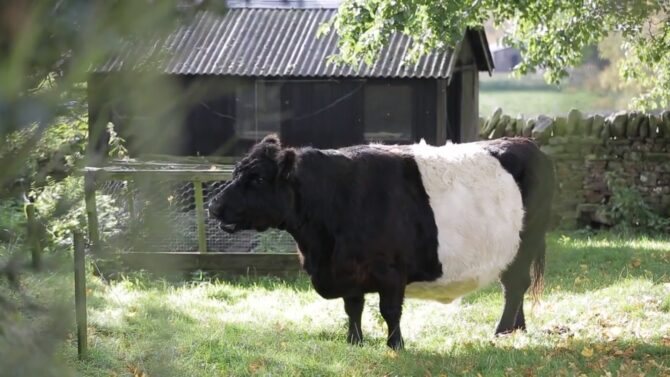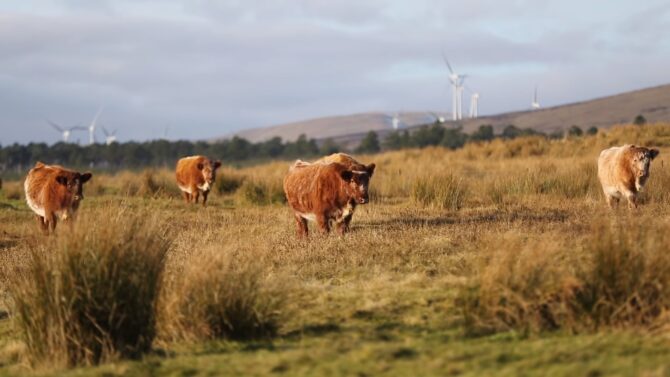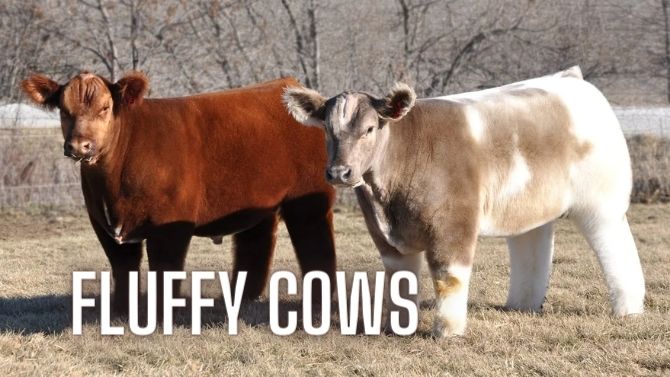Cows, often associated with the vast pastures and the countryside, have been an integral part of human civilization for centuries. While many of us are familiar with the typical short-haired dairy or beef cattle, there exists a fascinating world of long-haired, fluffy cow breeds that are not only a treat to the eyes but also have rich histories and unique characteristics. In this article, we will delve into the world of these fluffy bovines and explore ten of the most iconic long-haired cow breeds.
7. Highland Cattle
Origin: The Highland cattle, as the name suggests, hail from the rugged terrains of the Scottish Highlands and the Outer Hebrides islands. These regions, characterized by their harsh climates and challenging landscapes, played a pivotal role in shaping the unique features and resilience of this breed.
Appearance: Highland cattle are truly a visual delight. Their most striking feature is their long, shaggy coat that can cascade down, often covering their eyes. This coat comes in a spectrum of colors ranging from dun, red, black, to white. One intriguing historical tidbit is the predominance of the red color in these cattle. Legend has it that during Queen Victoria’s visit to the Scottish Highlands, she expressed a particular fondness for the red-colored Highland cattle. This royal preference reportedly led to selective breeding, making red the most commonly seen hue among these cattle today.
Characteristics: Beyond their appearance, Highland cattle are a marvel of nature’s design. Their double coat of hair is not just for show. The outer layer, which is oily, serves as a waterproof shield, ensuring that the cattle remain dry even during heavy rainfall. Beneath this layer is a soft, fluffy undercoat that provides insulation, keeping the cattle warm in the chilly Highland weather.
But it’s not just their coat that’s impressive. Despite their somewhat intimidating appearance, complete with long, curved horns, Highland cattle are known for their gentle nature. They possess a calm demeanor and are often friendly, making them a favorite among farmers and cattle enthusiasts alike.
6. Belted Galloway

Origin: The Belted Galloway traces its roots back to the Galloway region of Scotland, a land known for its rugged landscapes and challenging weather conditions. This region, with its mix of coastal plains, woodlands, and hills, has played a significant role in shaping the characteristics and resilience of the Belted Galloway breed.
Appearance: One of the most distinctive and easily recognizable cattle breeds, the Belted Galloway, is affectionately known as ‘belties’ due to the unique white belt that encircles their midsection. This belt stands out prominently against their usually black, dun, or red body, creating a stark contrast that’s hard to miss. Their thick, curly coat adds to their charm, making them a favorite subject for photographers and cattle enthusiasts.
Characteristics: Much like their Highland counterparts, the Belted Galloway boasts a thick, fluffy coat. This isn’t just a fashion statement; it’s a crucial adaptation that helps them stay insulated during the cold months, especially given the often harsh climate of their native region. Underneath their calm and docile exterior, however, lies a strong and robust creature. While they are generally known for their quiet temperament, making them a favorite among farmers, they can sometimes be a bit challenging to handle, especially if they feel threatened or cornered.
Distribution: The Belted Galloway’s journey from being a regional breed to gaining international recognition is truly remarkable. Officially established as a separate breed in 1921, the Belted Galloway is now considered a rare breed. Despite this, their unique appearance and hardy nature have garnered them fans worldwide. Today, while their numbers might be limited, they can be found in various countries, including the United States, Australia, the United Kingdom, Canada, and even as far as Brazil. Each of these regions has small populations of Belted Galloways, where they continue to enchant people with their distinctive appearance and gentle demeanor.
5. Chillingham
Origin: The Chillingham cattle trace their lineage to the historic grounds of Chillingham Castle in England. This ancient breed has roamed the parklands of the castle for centuries, with records suggesting their presence in the area for over 800 years. Their isolation in the park has led to a unique genetic makeup, untouched by crossbreeding with other cattle.
Appearance: Distinct from many of their domesticated counterparts, Chillingham cattle are smaller in stature. Their lean frame is complemented by upright horns, which both males and females sport. Their coat, typically white, adds to their distinctive look, making them easily recognizable among cattle breeds.
Characteristics: What truly sets the Chillingham cattle apart is their behavior. Unlike the domesticated cattle breeds we’re familiar with, Chillingham cattle exhibit behaviors akin to wild animals. They have never been tamed or bred for agricultural purposes. Their wild nature is evident in their interactions, as they can be aggressive and territorial, especially during mating seasons. This wild behavior means they aren’t suitable for traditional farming, and as such, they aren’t available for purchase.
Distribution: The exclusivity of the Chillingham cattle is another of their defining features. They are found only within the confines of an enclosed park in Chillingham Castle. This park, which has been their home for centuries, acts as a sanctuary, preserving their unique genetic lineage and wild behavior. Efforts have been made to ensure their conservation, given the historical and biological significance of the breed. Visitors to Chillingham Castle can catch a glimpse of these magnificent creatures, witnessing a piece of living history that harks back to a time when wild cattle roamed the British Isles.
4. Galloway
Origin: The Galloway cattle have their roots deeply embedded in the Scottish soil. Named after the Galloway region in southwest Scotland, this breed has been an integral part of the Scottish agricultural landscape for centuries. The rugged terrains and often harsh climatic conditions of the region played a pivotal role in shaping the Galloway’s resilience and adaptability.
Appearance: The Galloway cattle are a visual treat with their dense, fuzzy coats that can vary in shades of black, red, or the earthy dun. Their robust build, combined with their curly fur, gives them a distinctive and majestic appearance, making them stand out in any herd.
Characteristics: Galloway cattle hold the honor of being one of the world’s oldest established breeds, a testament to their enduring qualities and the value they bring. Their thick double coat isn’t just for show; it’s a crucial evolutionary adaptation. The outer layer is coarse, protecting the cattle from rain and moisture, while the inner layer is soft, providing insulation against the cold Scottish winters. This dual-layered coat ensures that the Galloway cattle can thrive in colder climates, making them a favorite for regions with harsh winters.
While their coat is a significant feature, their primary value in agriculture has been meat production. Galloway beef is renowned for its rich flavor, tenderness, and marbling, making it a sought-after choice among beef connoisseurs.
Distribution: The Galloway’s journey began in the 17th century in Scotland, and since then, they have traveled far and wide. While they originated in Scotland, their reputation for hardiness, combined with the quality of meat they produce, has led to their introduction in various parts of the world. Today, Galloway cattle can be found in pastures across different continents, from the meadows of Europe to the ranches of North America. However, no matter where they are, the legacy of the Scottish highlands is evident in every Galloway, a testament to their rich heritage and enduring qualities.
3. Luing

Origin: The Luing cattle owe their name and origin to Luing Island, situated off the west coast of Scotland. This island, with its unique blend of terrains and climates, has been the birthplace and nurturing ground for this distinctive cattle breed.
Appearance: As a hybrid breed, the Luing cattle beautifully encapsulate the physical traits of both their parent breeds – the robust Highlander and the versatile Beef Shorthorn. Their appearance is a harmonious blend, showcasing the ruggedness of the Highlander and the muscular build of the Beef Shorthorn. Their coat can vary in color, often influenced by the dominant genes of the parent breeds.
Characteristics: The Luing breed is a testament to the success of selective breeding. By crossing the Highlander, known for its resilience and adaptability, with the Beef Shorthorn, renowned for its meat quality, a breed was created that combined the best of both worlds. One of the standout characteristics of the Luing cattle is their impressive lifespan. Their robust health and vitality allow them to live longer than many other breeds. Furthermore, their reproductive efficiency is notable, with some cows giving birth to as many as 10 calves during their lifetime.
While their longevity and reproductive capabilities are commendable, it’s their meat that truly sets them apart. Luing beef is celebrated for its rich flavor, tenderness, and consistent quality, making it a preferred choice for many meat lovers.
Distribution: The story of the Luing cattle began in 1947 on Luing Island. In a relatively short span since their inception, they have garnered attention and admiration from cattle breeders and farmers alike. Their adaptability, combined with the quality of meat they produce, has led to their introduction in various parts of Scotland and beyond. Today, while Luing Island remains their ancestral home, these cattle can be found in different parts of the UK and other countries, continuing to be a symbol of successful and sustainable cattle breeding.
2. Shetland
Origin: The Shetland cattle, as the name suggests, trace their roots to the Shetland Islands, an archipelago located to the northeast of mainland Scotland. These islands, with their unique blend of maritime climate and rugged landscapes, have played a pivotal role in shaping the characteristics of the Shetland breed.
Appearance: Shetland cattle are easily distinguishable by their striking black and white markings. These patterns, often resembling patches, give them a distinctive and memorable appearance. Their size might be smaller than many other cattle breeds, but their bold markings ensure they stand out in any herd.
Characteristics: Don’t let their petite stature fool you; Shetland cattle are robust and hardy creatures. Their smaller size is an adaptation to the challenging environments of the Shetland Islands, allowing them to navigate the terrains with ease. While they might be diminutive, their value in agriculture is significant. Shetland cows are primarily raised for their meat, which is known for its rich flavor and tenderness.
Another defining characteristic of the Shetland cattle is their thick fur coat. This coat, a result of centuries of adaptation to the cold and often harsh weather of the Shetland Islands, acts as a natural insulator. It provides them with the warmth they need to thrive in colder climates, ensuring they remain healthy and active even during the chilliest months.
Distribution: The Shetland cattle are truly a Scottish treasure. While they originated in the Shetland Islands, their reputation for hardiness and the quality of meat they produce has led to interest from farmers and breeders beyond the islands. However, they remain predominantly native to Scotland, where they continue to be a symbol of the country’s rich agricultural heritage and the resilience of its livestock. Whether grazing on the pastures of the Shetland Islands or being showcased in agricultural fairs on the mainland, the Shetland cattle are a testament to the beauty and strength of nature’s creations.
1. South Devon

Origin: The Whitebred Shorthorn cattle trace their lineage to the diverse terrains of Britain. This breed, with its rich history, has been an integral part of the British agricultural scene for generations.
Appearance: The Whitebred Shorthorn, true to its name, boasts a fluffy white coat. This dense fur not only adds to their charm but also serves as a natural insulator, protecting them from the elements.
Characteristics: The Whitebred Shorthorn is celebrated for its meat, which is known for its rich flavor and tenderness. However, what truly sets this breed apart is its role in crossbreeding. They are often crossbred with Black Galloway cows to produce the Blue Grey hybrid. This hybrid cattle breed has gained popularity due to its ability to thrive on coarse grasses, making it an efficient and sustainable choice for many farmers.
Distribution: While the Whitebred Shorthorn is native to Britain, its value, both as a standalone breed and as a part of crossbreeding programs, has led to its introduction in various parts of Europe and Scotland. Whether grazing on the pastures of Britain or being showcased in agricultural events across Europe, the Whitebred Shorthorn continues to be a testament to the innovation and adaptability of cattle breeding.
FAQs
Why do certain cattle breeds have fluffy coats while others don’t?
The development of a fluffy coat in certain cattle breeds is primarily an evolutionary adaptation to their environment. Regions with colder climates or harsh weather conditions necessitate a thicker coat for insulation and protection against the elements. Over time, breeds native to such regions have developed denser coats to survive and thrive.
Are fluffy cattle breeds more challenging to maintain than short-haired breeds?
Not necessarily. While fluffy cattle breeds might require more grooming to keep their coats clean and free from pests, their hardy nature, adapted to challenging climates, often means they are robust and less prone to certain illnesses. However, their grooming needs can make them slightly more labor-intensive.
How does the meat quality of fluffy cattle breeds compare to other breeds?
The meat quality can vary across breeds, but many fluffy cattle breeds are known for producing high-quality, flavorful meat. The diet, environment, and overall care of the cattle play significant roles in determining meat quality, irrespective of the coat type.
Are there any specific health issues associated with long-haired cattle breeds?
Fluffy cattle breeds, due to their thick coats, can be more susceptible to external parasites like ticks or lice. Regular grooming and health checks are essential to ensure they remain free from such issues. Additionally, in warmer climates, they might be at risk of overheating, so providing shade and ample water is crucial.
Can fluffy cattle breeds thrive in warmer climates?
While many fluffy cattle breeds have evolved in colder regions, they can adapt to warmer climates with proper care. It’s essential to provide them with adequate shade, ventilation, and water. Some farmers might also choose to trim the coat during hotter months to help the cattle stay cool.
Are fluffy cattle breeds suitable for dairy production?
While some fluffy cattle breeds were historically used for milk production, many have transitioned primarily to meat production due to various factors, including adaptability to modern dairy farming techniques. However, there are still some fluffy breeds that are valued for their milk, though they might not be as prolific as specialized dairy breeds.
Conclusion
The realm of fluffy cattle breeds is a testament to nature’s adaptability and the rich tapestry of agricultural heritage across regions. From the rugged terrains of Scotland to the historic grounds of English castles, these breeds have evolved, each telling a unique story of survival, adaptation, and beauty. Their thick coats, a blend of function and aesthetics, serve as a reminder of the challenges they’ve faced and the climates they’ve conquered.
Whether you’re a farmer, a culinary enthusiast, or someone simply captivated by their majestic presence, these fluffy cattle breeds offer a fascinating journey into the world of bovines. As we continue to explore and appreciate the diversity of livestock, let’s ensure that these breeds, with their rich histories and contributions, are celebrated and preserved for generations to come.






